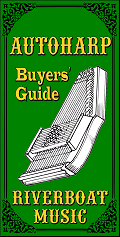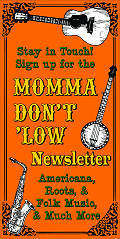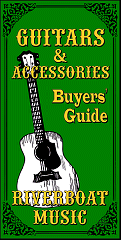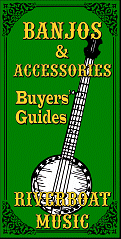 George Foss' G/D Autoharp Reconfiguration |
 |
| 



|
George Foss' G/D Autoharp ReconfigurationGeorge Foss (1932-2002) was a Julliard grad, a musicologist, a professor, and an indefatigable researcher.His many interests included Appalachian music and the instruments on which it has been played. One of those instruments was the autoharp. He saw much more potential in them than most other folks with "classical" backgrounds. Soon, he was experimenting with autoharps that are tuned to play only one or two keys, often called "diatonic" or "semi-diatonic," respectively. (Diatonic means that an instrument has only the notes of a single major scale and its relative minor. For example, a piano without black keys has a diatonic C major and A minor scale.) Eventually, Foss wrote the definitive book on the subject: Going Diatonic: A Comprehensive Guide to Autoharp Conversion. Unlike many autoharp resources, it draws heavily on Foss' knowledge of acoustics and music theory. Unfortunately out of print, it explains many things about overtones and related topics having to do with the physical properties of the strings and the relationships that the tones produce. For example, Foss explained why a C chord bar deadens the low E string, even though E is part of the chord: because playing the third in the bottom of a major chord would add overtones that muddy the sound of the higher-pitched strings. He also listed many advantages of diatonic autoharps, including:
Consider a Junker - All of this may sound too good to be true, and you may be hesitant to carve up your baby until you're entirely sure of what you're doing. I totally understand. But I also live in a country where used autoharps in playable or restorable condition are widely available for a reasonable cost. So if you're doubtful about the value of this kind of massive reconfiguration, consider acquiring a second autoharp you can experiment on without being afraid of hurting your first autoharp. Just don't be surprised if, once you've converted the "junker," you find yourself enjoying it more than your pristine original-condition autoharp. Why Semi-Diatonic?Foss would rather have had one truly diatonic autoharp for every key he was likely to need, but he realized that most harpers preferred to be able to play two keys on their harps, making them semi-diatonic. But which two keys? I recently led a "Folk jam" that was joined by a fellow with a splendid Orthey D/A semi-diatonic autoharp (designed to play songs in D and A). Unfortunately, many of the songs that the other members picked are traditionally played in G, so he had to sit out almost every other song. Some Carter Family songs are usually performed in F or C because those were the only supported keys of the early autoharps Sarah started out with. But anyone choosing to build an F/C diatonic would find themselves sitting out many Folk, Country, or Bluegrass songs, which are more likely to be performed in G and D. Still, if you perform with an ensemble that frequently plays songs in F and C, that might be the best choice for you. And - don't panic - lots of folks who love autoharps and play with multiple ensembles have multiple autoharps, each with a different setup. They might keep a chromatic autoharp (the factory version with all the sharps and flats) to play in a group that does popular mid-century songs (often performed in flat keys like F, Bb, and Eb). And a G/D semi-diatonic autoharp for singing with Folk, Country, or Bluegrass ensembles. And an A/E semi-diatonic for ensembles driven by fiddle players. Yes, autoharps can get heavy and awkward when you start dragging a bunch of them around, but I grew up with tenor saxophone, so I'm used to heavy and awkward. Foss' compromise when asked to design a dual-diatonic or "semi-diatonic" autoharp was to add "lock bars." These are built like chord bars, but typically silence only one or two tones - the notes that don't belong in one of the autoharp's chosen keys. So if you have a G/D autoharp, you would have one "lock bar" that silenced the C# strings for when you played in G. You'd have another lock bar that silenced the C strings when you played in D. Each would have some mechanism for locking it down during the course of the song. This would, essentially, make a G/D autoharp into a pure G diatonic when you were playing in G or a pure D diatonic when you were playing in D. Not everyone who makes a semi-diatonic autoharp does this. Why are G/D Autoharps so Popular/ - G and D are the most popular Folk and Country keys (though C, A, and E do make an appearance). D is the easiest key to play on guitar, and it remains the default key for a lot of singer-songwriters. G is the favorite key of many Bluegrass banjo players, and it's a very popular key in Folk and Country as well. So if you like Folk, Bluegrass, Country, or other traditional music forms, and you have to choose two keys for your primary or only semi-diatonic autoharp, you'll probably find a G/D set up most useful. George's SolutionThe following configuration was first published by George Foss in his book Going Diatonic. It demonstrates George's concerns about issues like not playing the third in the lower octave, not doubling notes in the higher octave, and not having the highest string tuned to a pitch that most chords wouldn't use. Many of the strings are tuned up a step or half-step, which George considered safe, though some experts call for an entirely different string setup for diatonics. The graphics below link to pdf files that show how the most important chord bars would be cut for a 21-chord G/D autoharp (though George preferred to have fewer chord bars on his diatonics). Note about 12- or 15-Chorders: If you start with a 12- or 15-chord autoharp, you???ll soon realize that there need to be chunks of felt at the end of each chord bar (not shown in this drawing). Compare our drawings with the chord bars from your autoharp to see what I mean. The chord bars are 10 1/8 inches long. Before you start cutting felts, please check to make certain your chart has printed at exactly 100%. Fold the printed chart and hold it against the strings on your autoharp to verify the accuracy. If necessary, adjust the scaling on your print screen to get the correct string spacing.
Mark your chord bars according to this chart, then hold your marked chord bars over the strings to make certain they align properly. Notch a V where each string needs to be ???open.??? Then test the chord bar by holding it on the strings and strumming. Save all the little bits of felt you carve out, at least until every chord bar is finished and tested. You'll need some of them at least, for when you screw up (unless you're better at this than I am). Chord Bar Sequence Foss' book aso includes a recommendation for arranging the chord bars (and their buttons) in a logical manner. Our drawing to the right shows his recommended setup. Foss' book aso includes a recommendation for arranging the chord bars (and their buttons) in a logical manner. Our drawing to the right shows his recommended setup.
Some of the chords he chooses to include aren't on his chart, but the following section tells what they are and how to make them. About 15-Chord Diatonics - Many autoharp players, especially folks in Folk, Country, and Bluegrass, find that twelve or thirteen chords are all they need, which leaves them two chord bars to make "locking" bars. If you could slide the buttons around on a 15-chorder like you can on a 21-chorder, you could easily create a setup like the one shown above right. Unfortunately, it's not that easy. That leaves folks who want to reconfigure a 15-chorder as a diatonic with three choices:
Whatever arrangement you choose, if you decide to add another diatonic to your stable, consider using the same relative chord arrangement for each one. For example, an F/C diatonic in the same arrangement would be F lock, Bb, Gm, Csus4, F, Dm, C7, C, Am, G7, G, Em, E7(minus the third), Gsus4, C lock. That way, when someone says they want to play a song in F that you're used to playing in G, you can just switch out your autoharp and play it the same way you're used to. More ChordsThe charts show the foundational chords for the keys of G and D. Of course, many more chords are possible within those two key structures. To add A7, simply make a second A Major chord bar and cut a notch for one G string in the middle octave and one G string in the upper octave. The notes you would use would be A, C#, E, G. The strings for C# and E would only be open in the middle and top octaves. For a D7, make a second D Major chord bar and cut notches for C in the middle and upper octaves. The notes you would use would be D, F#, A, and C (natural). The strings for F# and C would only be open in the middle and top octaves. If you want to be able to play the chords for songs in A, you could add a "cheater" E7. Start with the plans for an Em chord bar, but deaden the Gs, and open the D strings in the middle and high octaves. If there's a G# in the melody, you won't be able to play it, but if you're just playing chords, no one will realize that the "third" note of the E7 chord is missing - piano arrangements do this all the time. (One expert told me this was a bad idea, but didn't say why. Many people do it and just don't tell anybody.) The notes you would use would be E, B, and D. The strings for D would only be open in the middle and top octaves. Some people find "suspended fourth" chords helpful. In the keys of G and D, you would likely use Dsus4 and Asus4. A "suspended fourth" chord raises the third of the chord one half-step. It usually "resolves" to a regular seventh chord. (On worship music, this tends to be mislabeled "+4" or other labeling that implies that the third is still sounding. It's not. Don't ask me how I know this.)
If you're playing Celtic music (or certain Fleetwood Mac songs), you might get some use out of "open fifth" chords. These are "chords" in which the third doesn't sound at all. For example, you could
If you want to play modern or Calypso music, you might find Major 7th chords helpful. Within the G/D scale structures you can:
For modern, Calypso, or traditional Gospel music, you may find 6th chords helpful. Within the G/D scale structures, you can:
Obviously, that's too many choices, even for a 21-chorder, but it hopefully gives you some options. Some working autoharp players make most or all of these. Then they keep a stack of extra chord bars in the case, so when they show up for a recording session that - surprise! - calls for some odd chord, they can just pop out some chord bar they're not going to be using that day, and pop the unusual chord bar in its place. As a Folksinger choosing mostly to play in G and D, I'd choose chords that are most likely to be useful in those keys, such as
On a 21-chorder converted to D/A, I could choose up to 19 chords and still have two chord bars free to convert into "lock bars" if I wanted. Or if I really wanted to get crazy, and didn't mind playing my autoharp on a table, I could convert a Chromaharp Caroler (27-chorder) and add almost all of the chords I've listed. Okay, that's just crazy. Not that it will stop me from doing it if I ever have the time. ConclusionWe are providing this content mostly because people who are thinking about "taking the plunge" into a diatonic setup have all sorts of questions, and the best book to answer those is out of print. Plus we've added our own content that wasn't available in 1990, not to mention creating new, cleaned-up graphics.Some folks will wonder why we didn't do chord layouts for the seventeen chords that aren't shown in the illustrations. Or for other semi-diatonic configurations like F/C, C/G, D/A, or A/E. The truth is, that
That said, I don't want to leave you "hanging" on some point, so I will gladly answer questions sent to me through our contact page. After all, reader questions are the main way I get ideas for new articles. Best of luck!
And please stay in touch! All material, illustrations, and content of this web site is copyrighted (c) 2001, 2002, 2003, 2004, 2005, 2006, 2007, 2008, 2009,
Note: HarpersGuild.com(tm) is Paul Race's name for his resources supporting the history and music of the North American Heartland as well as additional kinds of acoustic and traditional music.
For questions, comments, suggestions, trouble reports, etc. about this page or this site, please
contact us.
| ||||||||||||||||||||||||||||||||||||||||||||||||||||||||||||||||||||||








































